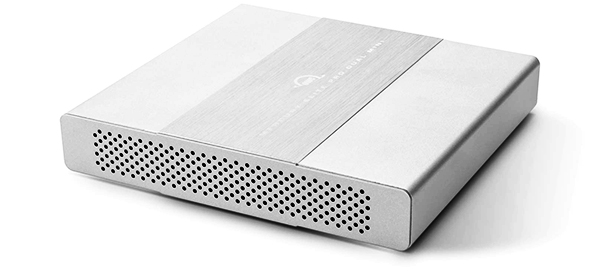Most photographers would like to spend more time shooting and less time editing and developing image files on a computer. One way to speed up the process is to select equipment that accelerates those tasks.
There are plenty of resources with suggestions for maximizing efficiency with Photoshop and Lightroom in both hardware and software setup (such as here and here.) In a nutshell, on the hardware side a fast CPU with 4-6 cores, an SSD for OS and programs, adequate GPU (growing in importance, but still a modest factor for most Photoshop operations), and fast storage for where the files reside are the guidelines for top performance. However, the last element in this string often escapes emphasis. When you work with files, they eventually have to be saved, and the saving process takes time; if you can speed that up you gain incremental efficiency.
Storage devices, until recently, have been slow to increase data throughput. Spinning hard drives (HDDs) have been around for decades and though their capacity has grown greatly their speed for transferring (saving) data hasn’t. Solid state drives (SSDs) have leaped ahead in terms of transfer rates, especially those with the most recent form factors and interface specifications. Data pipelines inside computers make a big difference. SATA has been the predominant storage interface until recently when PCIe has significantly raised the throughput ceiling, especially with the NVMe specification. A prime example is Samsung’s 960 Pro M.2/NVMe which has a maximum sequential read speed of 3,500MB/s compared to modern 7,200RPM HDDs average speed range of 80-160MB/s. Price and capacity are still major factors where HDDs prevail, but that differential is gradually closing too.
So, is there a way to improve one’s desktop editing efficiency by melding several current technologies without springing for the very latest expensive cutting edge equipment? Yes there is—OWC’s new Mercury Elite Pro Dual Mini external enclosure for 2.5” drives.

What sets this small device apart is the recently upgraded USB 3.1 Gen 2 interface which allows data transfer speeds up to 10 Gbps (1250MB/s). The unit will house two 2.5” SATA HDDs or SSDs, and can be configured as independent drives (IND), Span (combines the two drives together into one volume without a speed increase), RAID 0 (fastest solution), or RAID 1 (mirroring for protection against data loss). The connector is a USB Type-C plug and the unit is bus-powered (or optionally with an external wall plug).
Here’s the payoff. When using two SATA 2.5” SSDs in RAID 0, OWC advertises sustained data transfer speeds of up to 738MB/s, well above the ceiling of any individual SATA III (600MB/s) drive. By comparison, with two HDDs (instead of SSDs), OWC lists a max of 291MB/s throughput using RAID 0.
There’s a caveat here of course—you need a computer with USB 3.1 Gen 2 capability. Quite a few recent laptops and some desktops are so configured, or, if you have an open PCIe slot (4, 8, or 16 lane) you can add a card (similar to this one, though many different brands are available) to supply the connectivity.
My plan for this device? Two Samsung 850 EVO 2TB SSDs in RAID 0 as the primary drive for original photos immediately backed up with two or more HDDs. That would provide one location for most of my image files with the fastest time to save within my current desktop system. I fully expect the next generation of desktop computers will have motherboards with at least one M.2 slot with PCIe/NVMe interface for blazing performance and we’ll wonder how we put up with slow data transfer rates for so long.
